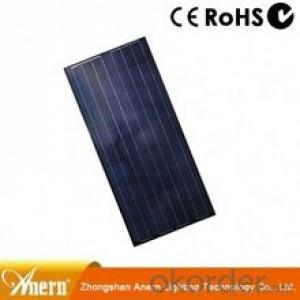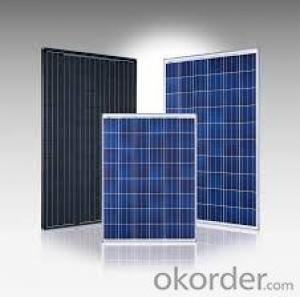Poly 156X156mm2 Solar Cells Made in Class 1
- Loading Port:
- Shanghai
- Payment Terms:
- TT OR LC
- Min Order Qty:
- 6500 watt
- Supply Capability:
- 6000000 watt/month
OKorder Service Pledge
OKorder Financial Service
You Might Also Like
The operation of a photovoltaic (PV) cell requires 3 basic attributes:
The absorption of light, generating either electron-hole pairs or excitons.
The separation of charge carriers of opposite types.
The separate extraction of those carriers to an external circuit.
In contrast, a solar thermal collector supplies heat by absorbing sunlight, for the purpose of either direct heating or indirect electrical power generation from heat. A "photoelectrolytic cell" (photoelectrochemical cell), on the other hand, refers either to a type of photovoltaic cell (like that developed by Edmond Becquerel and modern dye-sensitized solar cells), or to a device that splits water directly into hydrogen and oxygen using only solar illumination.Characteristic of Mono 156X156MM2 Solar Cells
You are gaining energy independence - add battery backup power for even greater energy security
The cost of electricity is only going to rise – insure against that rising cost
Adaptive cells change their absorption/reflection characteristics depending to respond to environmental conditions. An adaptive material responds to the intensity and angle of incident light. At the part of the cell where the light is most intense, the cell surface changes from reflective to adaptive, allowing the light to penetrate the cell. The other parts of the cell remain reflective increasing the retention of the absorbed light within the cell.[67]
In 2014 a system that combined an adaptive surface with a glass substrate that redirect the absorbed to a light absorber on the edges of the sheet. The system also included an array of fixed lenses/mirrors to concentrate light onto the adaptive surface. As the day continues, the concentrated light moves along the surface of the cell. That surface switches from reflective to adaptive when the light is most concentrated and back to reflective after the light moves along
Mechanical data and design
Format | 156mm x 156mm±0.5mm |
Thickness | 210μm±40μm |
Front(-) | 1.5mm bus bar (silver),blue anti-reflection coating (silicon nitride) |
Back (+) | 2.5mm wide soldering pads (sliver) back surface field (aluminium) |
Temperature Coefficient of Cells
Voc. Temp.coef.%/K | -0.35% |
Isc. Temp.coef .%/K | +0.024%/K |
Pm.Temp.coef. %/K | -0.47%/K |
Electrical Characteristic
Effiency(%) | Pmpp(W) | Umpp(V) | Impp(A) | Uoc(V) | Isc(A) | FF(%) |
18.35 | 4.384 | 0.526 | 8.333 | 0.63 | 8.877 | 78.39% |
18.20 | 4.349 | 0.526 | 8.263 | 0.63 | 8.789 | 78.54% |
18.05 | 4.313 | 0.525 | 8.216 | 0.63 | 8.741 | 78.32% |
17.90 | 4.277 | 0.524 | 8.161 | 0.625 | 8.713 | 78.04% |
17.75 | 4.241 | 0.523 | 8.116 | 0.625 | 8.678 | 77.70% |
17.60 | 4.206 | 0.521 | 8.073 | 0.625 | 8.657 | 77.36% |
17.45 | 4.170 | 0.519 | 8.039 | 0.625 | 8.633 | 76.92% |
17.30 | 4.134 | 0.517 | 8.004 | 0.625 | 8.622 | 76.59% |
17.15 | 4.096 | 0.516 | 7.938 | 0.625 | 8.537 | 76.80% |
17.00 | 4.062 | 0.512 | 7.933 | 0.625 | 8.531 | 76.18% |
16.75 | 4.002 | 0.511 | 7.828 | 0.625 | 8.499 | 75.34% |
16.50 | 3.940 | 0.510 | 7.731 | 0.625 | 8.484 | 74.36% |




 FAQ
FAQ
Q: What price for each watt?
A: It depends on the quantity, delivery date and payment terms, generally Large Quantity and Low Price
Q: What is your size for each module? Can you tell me the Parameter of your module?
A: We have different series of panels in different output, both c-Si and a-Si. Please take the specification sheet for your reference.
Q: What is your size for each module? Can you tell me the Parameter of your module?
A: We have different series of panels in different output, both c-Si and a-Si. Please take the specification sheet for your reference.
- Q:Can solar cells be used for powering space missions?
- Yes, solar cells can be used for powering space missions. Solar cells, also known as photovoltaic cells, convert sunlight into electricity. They have been widely used in space missions as they provide a reliable and renewable source of energy. Solar panels equipped with these cells are often deployed on spacecraft to generate power for various systems and instruments. The abundance of sunlight in space makes solar cells a practical and efficient option for powering space missions.
- Q:What is a monocrystalline Silicon Solar Cells?
- Monocrystalline Silicon Solar Cells consist of silicon in which the crystal lattice of the entire solid is continuous, unbroken to its edges, and free of any grain boundaries. Mono-Si can be prepared intrinsic, consisting only of exceedingly pure silicon, or doped, containing very small quantities of other elements added to change its semiconducting properties.
- Q:Do solar cells require maintenance?
- Yes, solar cells do require some maintenance. Regular cleaning of the solar panels to remove dust, debris, or any shading objects is necessary to ensure optimal sunlight absorption. Additionally, occasional inspection and maintenance of the electrical connections, inverters, and batteries (if present) may be required to ensure efficient and uninterrupted operation.
- Q:What is the payback period for solar cells?
- The payback period for solar cells refers to the time it takes for the cost of installing solar panels to be recouped through energy savings. It typically ranges from 5 to 15 years, depending on factors such as the initial cost of installation, electricity usage, and available incentives or tax credits.
- Q:What is the impact of solar cells on reducing dependence on foreign energy sources?
- Solar cells have a significant impact on reducing dependence on foreign energy sources as they harness the abundant and renewable power of the sun. By generating electricity locally, solar cells decrease the need for importing energy from foreign countries, promoting energy independence. This not only strengthens national security but also reduces the economic and political risks associated with relying on foreign energy supplies. Additionally, solar cells contribute to a more sustainable and environmentally friendly energy system, reducing carbon emissions and mitigating climate change.
- Q:Can solar cells be integrated into building materials?
- Yes, solar cells can be integrated into building materials. Building-integrated photovoltaics (BIPV) is a growing trend where solar cells are embedded into roofing materials, windows, facades, and other building components. This integration allows for the generation of electricity while maintaining the aesthetics and functionality of the building.
- Q:How do solar cells perform in humid climates?
- Solar cells can still perform efficiently in humid climates. However, high humidity levels can slightly reduce the overall performance of solar cells due to the moisture in the air. The moisture can create a thin film on the surface of the solar panels, which reduces the amount of sunlight that can be absorbed by the cells. Additionally, increased humidity can also affect the electrical connections and can potentially lead to corrosion or damage over time. Nonetheless, advancements in solar cell technology, such as anti-reflective coatings and improved waterproofing, have helped mitigate the impact of humidity on solar cell performance.
- Q:Can solar cells be used for large-scale power generation?
- Yes, solar cells can certainly be used for large-scale power generation. They have the potential to harness abundant sunlight and convert it into electricity on a massive scale. As technology and efficiency of solar cells continue to improve, they are increasingly being deployed in utility-scale solar farms, providing a sustainable and renewable source of power to meet the growing energy demands of our society.
- Q:Can solar cells be used in schools or educational institutions?
- Yes, solar cells can definitely be used in schools or educational institutions. Installing solar panels in schools not only helps in reducing electricity costs but also provides an opportunity to educate students about renewable energy sources and sustainability. It allows schools to become more environmentally conscious by reducing their carbon footprint and serves as a great educational tool to teach students about solar energy and its benefits.
- Q:How is the efficiency of a solar cell calculated?
- The efficiency of a solar cell is calculated by dividing the maximum power output of the solar cell by the total amount of solar energy it receives.
1. Manufacturer Overview |
|
|---|---|
| Location | |
| Year Established | |
| Annual Output Value | |
| Main Markets | |
| Company Certifications | |
2. Manufacturer Certificates |
|
|---|---|
| a) Certification Name | |
| Range | |
| Reference | |
| Validity Period | |
3. Manufacturer Capability |
|
|---|---|
| a)Trade Capacity | |
| Nearest Port | |
| Export Percentage | |
| No.of Employees in Trade Department | |
| Language Spoken: | |
| b)Factory Information | |
| Factory Size: | |
| No. of Production Lines | |
| Contract Manufacturing | |
| Product Price Range | |
Send your message to us
Poly 156X156mm2 Solar Cells Made in Class 1
- Loading Port:
- Shanghai
- Payment Terms:
- TT OR LC
- Min Order Qty:
- 6500 watt
- Supply Capability:
- 6000000 watt/month
OKorder Service Pledge
OKorder Financial Service
Similar products
New products
Hot products
Hot Searches
Related keywords






























